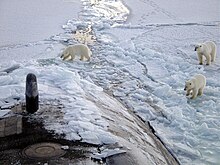USS Honolulu (SSN-718)
 Die Honolulu in Pearl Harbor | |
| Übersicht | |
|---|---|
| Bestellung | 15. September 1977 |
| Kiellegung | 10. November 1981 |
| Stapellauf | 24. September 1983 |
| 1. Dienstzeit | |
| Indienststellung | 6. Juli 1985 |
| Außerdienststellung | 2. November 2007 |
| Verbleib | Wird abgewrackt |
| Technische Daten | |
| Verdrängung | 6300 Tonnen aufgetaucht, 7100 Tonnen getaucht |
| Länge | 110,3 m |
| Breite | 10 m |
| Tiefgang | 9,7 m |
| Tauchtiefe | ca. 300 m |
| Besatzung | 12 Offiziere, 115 Mannschaften |
| Antrieb | Ein S6G-Reaktor |
| Geschwindigkeit | 30+ Knoten |
| Bewaffnung | 4 533-mm-Torpedorohre |
Die USS Honolulu (SSN-718) war ein Atom-U-Boot der United States Navy und gehörte der Los-Angeles-Klasse an.
Geschichte
Die Honolulu wurde 1977 bei Newport News Shipbuilding in Auftrag gegeben und 1981 auf der Werft des Unternehmens in Newport News, Virginia auf Kiel gelegt. Stapellauf und Schiffstaufe fanden 1983 statt, Namenspatron ist die Stadt Honolulu auf Hawaii. Das U-Boot wurde 1985 bei der US Navy in Dienst gestellt. Das Boot war das letzte Boot des ersten Bauloses der Klasse, alle folgenden Einheiten waren mit einem Vertical Launching System ausgerüstet.
Das Boot war das erste Boot dieses ersten Bauloses, das die Region um den Nordpol besuchte. 2003 tauchte die Honolulu durch arktisches Eis auf und nahm unter anderem Wasserproben für nordamerikanische Universitäten.
Nach insgesamt neun Einsatzfahrten in den westlichen Pazifik und den Indik (unter anderem 2000 mit dem Flugzeugträger USS Kitty Hawk (CV-63) und 2002 mit der USS Abraham Lincoln (CVN-72)) verließ das Boot seinen Heimathafen Pearl Harbor im Mai 2006 zum letzten Mal. Auf einer kleinen Verabschiedung sprachen dabei unter anderem Senator Daniel K. Inouye, ihr ehemaliger Kommandant Jonathan W. Greenert und der U.S. Pacific Fleet Commander, Admiral Gary Roughead.
Nach einer Patrouillenfahrt und der Teilnahme an der Übung Valiant Shield wurde die Honolulu im November 2006 in der Puget Sound Naval Shipyard im Rahmen des Ship-Submarine Recycling Programs vorläufig stillgelegt. Ein Jahr später wurde sie dann endgültig außer Dienst gestellt und wird anschließend zerlegt. Der Bug der Honolulu wurde dabei in einem Stück abgetrennt und an ein Schwesterschiff, die USS San Francisco (SSN-711), geschweißt, die 2005 mit hoher Geschwindigkeit einen unterseeischen Berg gerammt hatte.
Weblinks
Auf dieser Seite verwendete Medien
Three polar bears approach the starboard bow of the Los Angeles-class fast attack submarine USS Honolulu (SSN 718) while surfaced 280 miles from the North Pole. Sighted by a lookout from the bridge (sail) of the submarine, the bears investigated the boat for almost 2 hours before leaving. Commanded by Cmdr. Charles Harris, USS Honolulu while conducting otherwise classified operations in the Arctic, collected scientific data and water samples for U.S. and Canadian Universities as part of an agreement with the Arctic Submarine Laboratory (ASL) and the National Science Foundation (NSF). USS Honolulu was the 24th Los Angeles-class submarine, and the first original design in her class to visit the North Pole region. Honolulu was assigned to Commander Submarine Pacific, Submarine Squadron Three, Pearl Harbor, Hawaii.
The Flag of the United States Navy, as defined in Executive Order 10812 of April 24, 1959. The design is described there as:
The flag for the United States Navy is 4 feet 4 inches hoist by 5 feet 6 inches fly, of dark blue material, with yellow fringe, 2½ inches wide. In the center of the flag is a device 3 feet and 1 inch overall consisting of the inner pictorial portion of the seal of the Department of the Navy (with the exception that a continuation of the sea has been substituted for the land area), in its proper colors within a circular yellow rope edging, all 2 feet 6 inches in diameter above a yellow scroll inscribed "UNITED STATES NAVY" in dark blue letters.
The U.S. Navy flag is used for display purposes at ceremonies, parades, and other public functions where the U.S. Navy has an official presence, usually being carried by an honor guard on ceremonial occasions. It is not used for outdoor, fixed (permanent) purposes, and is not flown on Navy ships. Versions without fringe and different dimensions seem to be common, though it appears they are not technically the official U.S. Navy flag, as the executive order has not been amended.
Prior to 1959, the Navy Infantry Battalion flag was used to represent the U.S. Navy.
For more information, see the Navy's flag history page, SeaFlags, Flags of the World, U.S. Navy document NTP 13(B) [1], section 1710, and Navy regulation OPNAVINST 10520.1 (which replaced a similar SECNAVINST 10520.2D regulation from 1974).Pearl Harbor, Hawaii (May 13, 2006) - The Los Angeles-class submarine USS Honolulu (SSN 718) sails by the USS Arizona Memorial one last time before heading out on her 10th Western Pacific deployment. This will be the last deployment for the nuclear-powered fast attack submarine. Following the deployment, the Honolulu is scheduled for decommissioning and will transit to Bremerton, Wash to begin the process. U.S. Navy photo by Journalist 2nd Class Corwin Colbert (RELEASED)



